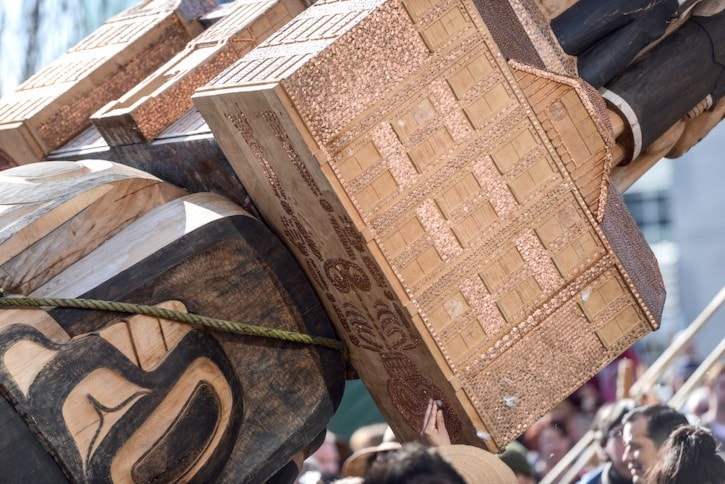On April 1, James Hart, master carver and Hereditary Chief of Staastas, raised Reconciliation Pole on Musqueam Territory in the heart of the University of British Columbia campus. According to Hart, the pole tells the story of the time before, during, and after Canada’s Indian Residential School system. This is indeed an important story to tell because, according to Senator Murray Sinclair, residential schools were a system of “cultural genocide,” the attempted elimination of Indigenous culture through education.
This elimination of culture was violent and deadly, as remembered by the 68,000 copper nails on Reconciliation Pole. Each nail represents a lost child, taken from his or her family with the intent of killing entire cultures. While the exact number of children who died from residential school abuses is disputed, the intent of the schools was to kill the spirit of every Indigenous child.
The failure of residential schools to fulfil this intent is testament to Indigenous resiliency and resistance. This calls on us to question everything about the historical proponents of forced assimilation through education. It also calls on all teachers to reflect on our profession’s historic role in this epic wrong. Education used as a tool of violence is profoundly unethical, to say the least. “Never again” must be our profession’s mantra, lest we fail our students yet again in supporting cultural genocide.
Residential schools are not just history. They are part of today’s conversation about ending the colonization of Canada. Colonization is a set of policies, priorities, laws, attitudes, ownerships, and practices that result in the living conditions of more than 1.5 million people in Canada today. Moreover, everyone in Canada is enmeshed in this project. Colonization is racialized. It is built on the construction of racial identities and status. Be you indigenous or otherwise, colonization includes you by virtue of placing each of us in relation to one another on the basis of race within an unfair social hierarchy.
The scars of residential schools are visible in contemporary conflicts over the meaning of the school system itself. According to the Globe and Mail, Senator Lynn Beyak continues to defend her position that residential schools did good, not just wrong. Beyak was removed from the Senate Standing Committee on Aboriginal Peoples after saying there were “good deeds” carried out by residential school teachers.
Beyak says she speaks for a “silent majority” that wants to respect the nurses, teachers, foster families, and others whose work within the residential school system was good for indigenous people, saying that she speaks “in memory of the kindly and well-intentioned men and women and their descendants […] whose remarkable works, good deeds and historical tales in the residential schools go unacknowledged for the most part and are overshadowed by negative reports.”
Beyak misses two points. First, no good deed can overcome the cumulative effect of cultural genocide. If the overall intent of a school system is forced assimilation through compulsory participation, then even the well-intentioned are, at least in part, responsible for the final outcome.
Second, it is the job of the well-intentioned to challenge and resist a grave injustice, not to let it proceed.
Let us remember that teachers and nurses are members of professions. As professionals, they are duty-bound to the ethics of doing no harm and honouring the dignity of each person with whom we work. We can’t change the past, but we can learn from it. It is only right for today’s professionals who work with indigenous children and youth to heed history’s lesson: do no harm to our students. Good deeds do not excuse professionals from professional duties.
Reconciliation Pole does not end at the tragedy of the residential school system that was imposed on Indigenous peoples. Cultural resiliency, the resistance of Indigenous children and families, goes beyond the residential school era. Near the top of the pole, below Eagle (representing power, togetherness, and determination), is a canoe and longboat travelling forward. The boats are travelling side by side, different but together. The canoe represents First Nations and their governances. The longboat represents the rest of us.
We do not need to reject history’s lessons to travel in the right direction today — together but different, united in solidarity.
